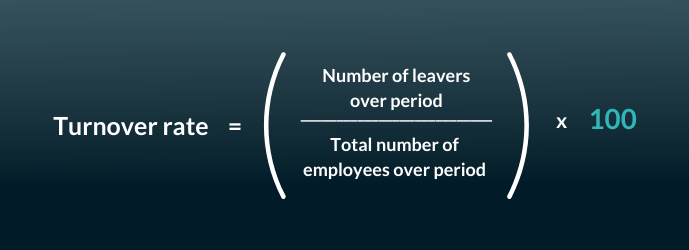How to calculate the cost of employee turnover
To understand how much employee turnover costs your business, first, we must calculate the employee turnover itself.
This is the calculation used:

The “period” could be any period of time but is typically monthly or yearly. And the “number of leavers” tends to include all leavers from the business – for example, those who were made redundant as well as those who were dismissed.
Many companies will also calculate separate figures to show departures that are unplanned or unpredictable that could have an adverse impact on the business.
You can also calculate turnover metrics focused on:
- High-performance roles – as opposed to roles that are likely to be high in turnover due to their nature e.g. temporary positions or seasonal jobs
- Turnover due to promotions or transfers
- Average employee tenure
Depending on the tools available, many HR teams will segment the data to ensure they can measure where turnover is highest or lowest throughout the business. This can help leaders identify areas for improvement, especially when there are specific departments or teams experiencing consistent high levels of turnover.
Benchmarking your turnover rate
According to Ceridian, the average UK turnover rate is approximately 15% a year. This drops considerably when measuring only voluntary turnover.
Be careful when benchmarking as turnover rates vary massively depending on the industry. For example, professional office-based jobs are likely to have a much lower turnover rate than fast-paced retail roles that typically involve short tenures.
When does employee turnover become troublesome?
In truth, having staff come and go is healthy for a business. It helps bring fresh ideas and skills into the company, ensuring the talent hired is right for the goals of the business. Some companies embrace this benefit, such as Netflix, which states: “We keep only our highly effective people”.
That said, when turnover levels start to edge over average, it can cause a negative impact on a business as it incurs increasing costs.
The tangible costs of staff turnover include:
- Advertising and agency fees: the costs involved with hiring someone new, such as recruitment fees (typically 15-20% of the first year’s salary) or advertising fees
- Cost of temporary workers: when you can’t find the right permanent candidate, temp workers often incur higher cost-per-hour wages
- HR processes: on average, it costs a firm between £150 and £200 to recruit a new employee
- Interviewing: Each time a candidate is interviewed, there’s an opportunity cost due to the loss of time from the hiring manager(s)
- Training: Depending on the role type, some candidates will need compulsory training to enable them to do their job (such as manual handling training for a new warehouse operative) and often the employer will absorb these costs.
- Equipment and uniform: Whilst equipment (such as laptops and phones) can be given back to the employer and handed out to their replacement, smaller items like onboarding packs or stationery can add up in cost. Uniforms are often funded by the employer and not handed back when someone leaves, adding further costs to hiring new people.
The hidden costs
Whilst many costs of staff turnover are obvious and can be accounted for in financial spreadsheets, research shows there are also intangible costs that are forgotten about. These include:
1. Time to reach optimum productivity: It can take a new worker up to 50 weeks to achieve optimal productivity and working under productivity can lose the business money.
2. Cost of lost wages: Some new recruits cost businesses more than others depending on where they’ve come from. For example, hiring someone who has been long-term unemployed will take more resources than someone who has come from a similar role directly from another business.
3. Lost capital income: When an employee is operating under normal productivity levels, a business loses capital income. For example, if a high-performing sales consultant leaves and it takes months to recruit a new one and for them to get trained up, the business misses out on potential revenue.
To explore how to minimise your turnover costs through optimising employee engagement, chat to us.



